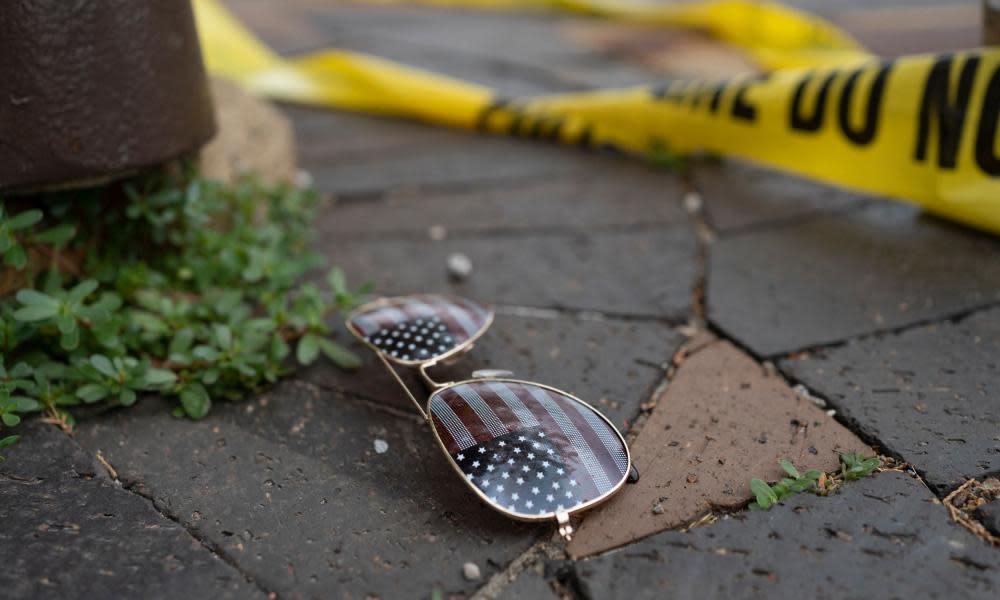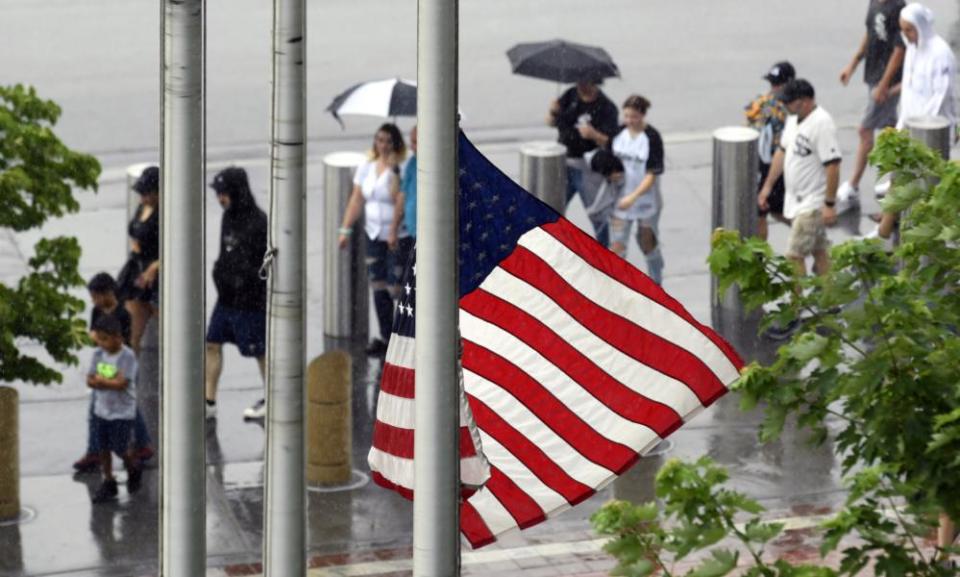As fireworks lit up the sky, firearms displayed an uglier face of US culture

The United States marked 246 years of independence with the traditional fireworks, flag-waving and barbecues – but this Fourth of July was also marred by an eruption of gun violence in dozens of cities across the nation.
As America celebrated its declaration of freedom from colonial rule on Monday, its national day became a twisted showcase of another form of US exceptionalism: its exceptionally easy access to guns and the resultant mayhem. While fireworks lit up the night sky, the ugly impact of firearms was also widely on display.
Related: Details emerge about victims of Highland Park Fourth of July shooting
The fireworks-firearms connection was not just a reporter’s metaphor. For Fourth of July paradegoers in Highland Park, a wealthy and largely white suburb north of Chicago that prides itself on its safety record, it became a harrowing reality: the Chicago Tribune reported that the happy throng initially assumed that the sound they heard at 10.14am local time on Monday was produced by joy-seekers igniting firecrackers.
Then someone shouted: “There’s a shooter,” and panic set in, scattering families and the local high school marching band in all directions.
By the end of the shooting spree, with at least 50 shots unleashed from a high-powered rifle by a rooftop sniper, six people were dead and at least 24 injured from bullet wounds or the stampede. Later on Monday a “person of interest”, identified as Robert Crimo III, 22, was taken into custody.
The Highland Park massacre added to a long and growing list of high-profile mass shootings in the US in recent weeks – the racist gun rampage in Buffalo, New York, on 14 May, in which 10 people were killed at a supermarket in a largely Black neighbourhood; and in Uvalde, Texas, where a gunman killed 19 children and two teachers at an elementary school two weeks later.
But it is not necessary to look back over the year for evidence of the bloodletting inflicted on US citizens by the country’s tolerance of deadly weapons: the Fourth of July weekend alone offered plenty of that. According to the Gun Violence Archive, which tracks mass shootings – defined as incidents in which at least four people are injured or killed – the three-day celebratory weekend added 13 such events to its database.
On one day alone – 4 July itself – the archive recorded six mass shootings that in total killed at least seven people and left 54 injured. The other five outbursts included a second catastrophe in the Chicago area that exploded just 13 minutes into Independence Day. At 12.13am on Monday five people were wounded in a drive-by shooting as they stood on the street in Chicago’s South Side. The injuries sustained included gunshots to the individuals’ arms, legs and knees.
In addition to the two mass shootings in the Chicago region others were recorded in Boston, Sacramento and Kansas City.
Also on the list was Richmond, Virginia, a town with its own rich independence history: Patrick Henry made his “Give me liberty or give me death” speech here in 1775. On Monday, Richmond was in the news for a less auspicious reason: four men and two women were shot on the street in the early hours.
That startling litany of mass shootings was in itself just the thin end of the wedge, as the US marked 4 July with umpteen other smaller outbreaks of gun violence that were too quotidian to make the headlines. NBC Chicago estimated that in that city alone at least nine people were killed and 57 wounded by gunfire over the Independence Day weekend.

By the end of a day of celebrations in Philadelphia, two police officers had been shot and treated for bullet grazes to their forehead and shoulder. In other towns and cities, the fear of gun violence was enough in itself to set scores of spectators bolting even where no shooter was present.
In Lake Eola, Florida, hundreds of people stampeded at a fireworks display on Monday night after news spread that an unidentified noise was gunfire. Orlando police said that there was no evidence that a shot had been fired.
On a political level, the orgy of gun violence on America’s most revered day was especially awkward in that it came less than two weeks after Senate leaders secured a modest package of gun controls that restricted access to guns by domestic abusers and awarded gun safety funds for schools and mental health programs. Despite its limited remit, the reforms were the most substantial attempt at abating gun violence to emerge from Congress in decades.
According to the Small Arms Survey database, there are almost 400m firearms in civilian possession in the US. That is vastly more than any other country – whether expressed numerically (India comes next with 71m) or per capita (the US has 121 firearms per 100 residents, with Yemen, currently riven by an active civil war, coming in second with 53).
Democratic politicians responded to the scourge of violence over the weekend with by now familiar laments about the lack of safety for ordinary citizens. The governor of Illinois, JB Pritzker, said it had been devastating to watch the celebration of America’s founding “ripped apart by our uniquely American plague”.
Pritzker said that a day “dedicated to freedom” had put into stark relief “the one freedom that we as a nation refuse to uphold – the freedom of our fellow citizens to live without the daily fear of gun violence”.
But there were also signs of political exhaustion in the face of the unrelenting epidemic. Joe Biden, who had promised that the recent gun control reforms he signed into law would save lives, barely mentioned the Highland Park massacre when he gave the formal Fourth of July speech on the White House lawn.
On the other side of the aisle, Darren Bailey, the Republican party’s nominee in the 2022 governor’s race in Illinois, did address the Highland Park shooting. But he had a controversial way of putting it.
As the shooter was still at large, Bailey addressed a group of supporters in a location close to the site of the killings, and gave the usual refrain about praying for the victims. Then he added: “And then let’s move on and celebrate freedom and the independence of this nation.”
Bailey later said he apologized “if in any way we diminished the pain being felt across our state today”.

